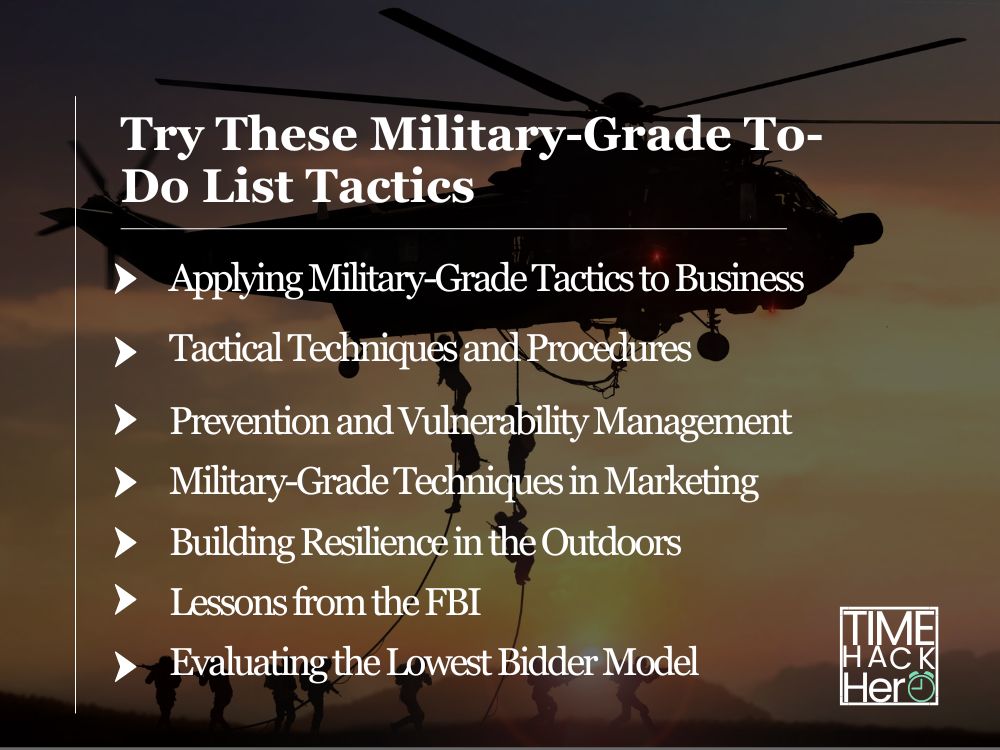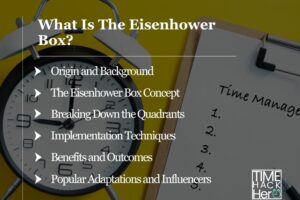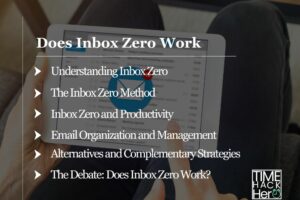In today’s fast-paced world, it can be challenging to stay organized and on top of our ever-growing to-do lists. One way to tackle this issue is by adopting military-grade tactics, specifically the CARVER matrix, to help prioritize tasks and projects effectively. By leveraging the techniques used in military operations, individuals can address their daily responsibilities with increased efficiency, clarity, and focus.
The CARVER matrix operates on a ranking scale for tasks or projects, measuring their overall importance and urgency. By assigning values to various factors, such as how clear the task is or how vital it is to overall goals, users can quickly gain better insight into which items require immediate attention. With this system, even the most daunting to-do lists become manageable, and users can make informed decisions when prioritizing their time and energy.
Utilizing military-grade techniques like the CARVER matrix in everyday life can provide significant benefits to those looking to increase their productivity and organization levels. By approaching our responsibilities with the same strategic mindset as those in the military, we can conquer our to-do lists and stay focused on achieving our goals.
Table of Contents
Applying Military-Grade Tactics to Business
Strategic Planning
One important aspect of military operations is strategic planning. Similarly, businesses can benefit from well-laid plans. To implement military-grade tactics in business, consider establishing clear objectives and priorities. This includes assessing the organization’s strengths and weaknesses to identify areas for growth or improvement. Developing a comprehensive strategic plan can help streamline decision-making processes, making companies more agile and responsive in a competitive landscape.
Efficiency
In the military, efficiency is essential for maintaining focus and speed during missions. For businesses, improved efficiency can lead to higher productivity, lower costs, and ultimately, increased profit margins. To adopt military-grade tactics for efficiency, consider the following:
- Clearly define roles and responsibilities within the organization
- Establish standard operating procedures to streamline tasks
- Conduct regular performance evaluations to identify and address inefficiencies
- Encourage collaboration and clear communication among team members
Resource Allocation
Proper allocation of resources is crucial for both military and business success. This involves prioritizing tasks based on their level of importance and cautiously managing resources to avoid waste. Military strategies, such as the CARVER matrix, can be useful when applied to business circumstances. This method involves ranking tasks based on criteria such as criticality, accessibility, and vulnerability. Here is a sample CARVER matrix, using a ranking scale of 1 to 5:
| Task | Criticality | Accessibility | Vulnerability | Overall Score |
|---|---|---|---|---|
| Task 1 | 3 | 4 | 2 | 9 |
| Task 2 | 5 | 2 | 4 | 11 |
By employing military-grade tactics in strategic planning, efficiency, and resource allocation, businesses can gain a competitive edge and optimize the use of their resources.
Tactical Techniques and Procedures
Setting Clear Objectives
In any operation, setting clear and realistic objectives is a fundamental tactical technique for success. The military emphasizes the importance of establishing well-defined targets so that personnel can focus their efforts and react accordingly to achieve the desired outcome.
- Define specific, measurable, attainable, relevant, and time-bound (SMART) objectives
- Prioritize objectives based on their impact and urgency
- Break down larger objectives into smaller, manageable tasks
Efficient Use of Resources
Military tactics involve the effective use and management of available resources. Efficient resource utilization ensures that personnel, equipment, and time are allocated optimally to accomplish the mission. This practice can be adapted to everyday tasks and projects by considering the following:
- Allocate resources (e.g., time, finances, workforce) according to objective priorities
- Minimize resource waste by improving processes and eliminating redundancies
- Regularly review and adjust resource allocation based on changing circumstances and objectives
| Resource Type | Considerations |
|---|---|
| Time | Estimate required time; track actual time spent on tasks |
| Personnel | Delegate tasks based on skillsets and availability |
| Equipment/Materials | Ensure equipment is suited for the task and well-maintained |
Implementing Intelligence and Security Measures
The military emphasizes the value of gathering and analyzing intelligence in tactical planning. Similarly, applying security measures to protect sensitive information and resources is essential. Civilians can apply these concepts by:
- Conducting research to understand both the context and potential challenges associated with a project or task
- Identifying potential risks and implementing safeguards to mitigate them
- Continuously monitoring and evaluating performance to identify areas for improvement and anticipate potential issues before they arise
By incorporating these tactical techniques and procedures into your everyday to-do list, you can improve your overall efficiency and effectiveness in completing tasks and achieving your goals. Be prepared to adapt and react to changing circumstances by continuously reassessing priorities and resource allocation.
Prevention and Vulnerability Management
Proactive Measures
Prevention and vulnerability management in any operational context require a proactive approach. The following strategies can help in identifying and addressing vulnerabilities in infrastructure and processes:
- Regularly update software and hardware systems
- Conduct periodic security awareness training for staff
- Implement cybersecurity best practices, such as multi-factor authentication
Risk Assessment
The risk assessment process involves evaluating potential targets and their associated risks. Military-grade tactics often use a ranking scale, such as 1-5 or 1-10, to prioritize and focus on the most critical vulnerabilities:
| Vulnerability | Severity Ranking |
|---|---|
| Example 1 | 3 |
| Example 2 | 8 |
Key factors to consider during a risk assessment include:
- Probability and impact of a vulnerability being exploited
- The overall operational impact on the organization or infrastructure
- The resources required to effectively mitigate the risk
Contingency Planning
Contingency planning is essential in addressing vulnerabilities and preventing disruptions to operations. This involves:
- Identifying recovery objectives and strategies
- Allocating resources for contingency measures
- Regularly reviewing and updating contingency plans
Some action steps to include in contingency planning are:
- Develop communication protocols and incident response plans
- Establish backup systems and data recovery procedures
- Test contingency measures through simulation exercises
Military-Grade Techniques in Marketing
Precision Targeting
In the realm of marketing, precision targeting is a must. This military-grade technique involves meticulously identifying and segmenting your audience. By doing so, you can ensure that your marketing efforts are being directed toward the most relevant and high-potential customers. To achieve this, consider the following steps:
- Analyze your existing customer base and identify common characteristics.
- Conduct market research to identify potential customers that align with your brand or product.
- Create detailed buyer personas to help guide your marketing strategies.
- Utilize analytics and data to fine-tune audience targeting over time.
Maximizing Durability and Impact
Creating a robust and lasting impact on your target audience is essential for successful marketing. Military-grade techniques focus on maximizing the durability and effectiveness of your campaigns. Here are some strategies to employ:
- Develop clear, concise messaging that drives long-term brand recognition.
- Utilize lasting visuals and imagery that evoke emotions and create a connection with your audience.
- Strive for consistency in branding, tone, and messaging across all marketing channels.
- Monitor the performance of your marketing campaigns in real-time to determine areas of strength and weakness.
Testing and Adjusting Campaigns
Embracing a military-grade approach to marketing requires a continuous cycle of testing, learning, and iterating. This ensures your campaigns remain effective and capable of delivering desired results:
- Establish clear, measurable objectives for your marketing campaigns to gauge their effectiveness.
- Use split (A/B) testing to compare different marketing elements and determine which version produces the best results.
- Continuously monitor marketing data and analytics to identify patterns and trends.
- Make data-driven decisions to adjust and refine your campaigns over time.
Incorporating these military-grade techniques in marketing can help you achieve precision targeting, maximize durability and impact, and enable ongoing testing and adjustment of your campaigns for optimal results.
Building Resilience in the Outdoors
Planning for Adverse Conditions
When facing the outdoors, preparation is key to building resilience. Military professionals are skilled at anticipating and preparing for various challenges, making their tactics adaptable for your outdoor adventures. Start by:
- Researching weather and terrain conditions
- Identifying potential hazards and mitigation strategies
- Establishing contingency plans for emergencies
- Familiarizing yourself with local flora and fauna
- Ensuring to have adequate communication methods
Choosing the Right Gear
Selecting appropriate gear is crucial for resilience in outdoor environments. Consider the following when making your choices:
- Opt for high-quality and durable materials
- Prioritize essential items like shelter, warmth, and sustenance
- Invest in reliable navigation tools, such as a compass or GPS device
- Consider multi-functional items to save space and weight
- Test your gear beforehand to ensure reliability and familiarity
| Item | Details |
|---|---|
| Shelter | Tent, tarp, or bivvy sac |
| Warmth | Insulated sleeping bag, layers of clothing, emergency blanket |
| Sustenance | Non-perishable food, water purification tablets, energy bars |
| Navigation | Compass, map, GPS device |
| Multi-purpose | Swiss Army knife, paracord, carabiners |
Survival Techniques
Being knowledgeable in survival techniques can help increase resilience during outdoor activities. Some essential skills include:
- Making a fire: Collect dry materials and use a fire starter, matches, or a lighter to ignite a flame.
- Building a shelter: Construct a lean-to or debris hut to protect yourself from the elements.
- Signal for help: Use a mirror or an emergency whistle to attract attention in case of distress.
- Navigating with a map and compass: Learn fundamental map-reading skills and how to use a compass properly.
- First aid: Basic knowledge of first aid can help you tackle illnesses and injuries in the outdoors.
By incorporating these military-grade to-do list tactics, you’ll be better prepared to face challenges on your outdoor adventures, building resilience and improving your overall experience.
Lessons from the FBI
Investigative Methods
The FBI uses a variety of investigative methods to accomplish its mission. These techniques can be applied to everyday tasks for better organization and effective execution, such as:
- Intelligence gathering: Stay informed and gather relevant data before starting a task. This helps in decision-making and understanding the scope of the project.
- Assessing risks: Identify potential challenges and their impact on the task. This enables you to prioritize and focus on tasks with higher importance.
- Developing a plan: Break your task/project into smaller, manageable steps with clear objectives and set deadlines for each step.
Crisis Management
Crisis management is vital for the FBI when dealing with unexpected situations. Key elements of the FBI’s crisis management approach that can be applied to your to-do list include:
- Quick response: React promptly to unforeseen events to minimize damage and regain control of the situation.
- Adaptability: Be flexible and prepared to change plans when new information is available or when the situation changes.
- Communication: Maintain open, clear, and concise communication with all parties involved to ensure everyone stays informed and aligned with the objectives.
Negotiation Strategies
The FBI utilizes negotiation strategies in high-stakes situations. Some of these strategies can be applied to daily tasks to help in resolving conflicts and achieving goals:
- Active listening: Pay attention, ask questions, and show empathy when interacting with others, ensuring a better understanding of their needs and concerns.
- Finding common ground: Identify shared goals and interests to build stronger relationships and foster collaboration.
- Problem-solving: Approach disputes with a focus on finding mutually acceptable solutions, demonstrating respect and openness to different perspectives.
These lessons from the FBI can offer valuable insights into enhancing the effectiveness of your to-do list management by employing strategies and techniques that have been proven to work in high-pressure situations.
Evaluating the Lowest Bidder Model
Cost-Efficiency
The lowest bidder model is often used in various industries, including government contracts and construction projects. The primary advantage of this model is its focus on cost-efficiency. By selecting the lowest bidder, organizations aim to minimize their expenses and achieve their goals within budget constraints. However, it’s essential to consider other factors such as qualifications and experience when evaluating the lowest bidder to ensure that the resulting contract or project meets the required standards.
Quality and Reliability
While cost-efficiency is an essential factor, it’s also crucial to consider the quality and reliability of projects and products delivered by the lowest bidders. In some cases, low bids may result from shortcuts in materials or processes that may compromise quality or lead to potential problems in the future.
To counter and identify potential risks, it’s important for organizations to:
- Thoroughly review project proposals.
- Conduct background checks on bidder credentials and track records.
- Assess and mitigate potential risks associated with the lowest bids.
Sustainable Business
The lowest bidder model has implications for sustainability in both the business and the environmental sense. Businesses that consistently underbid might face issues managing their costs and resources, reducing their ability to invest in long-term growth and innovation. On the environmental side, the lowest bidder model could potentially encourage practices that prioritize short-term cost savings over long-term sustainability, such as using cheap materials with limited life spans or environmental impacts.
To promote sustainable business practices when using the lowest bidder model, organizations can:
- Implement contract clauses that emphasize adherence to environmental standards and regulations.
- Evaluate bidders based on their commitment to sustainable practices alongside their bid pricing.
- Encourage innovation and investment in efficiency, waste reduction, and materials that improve long-term project sustainability.









